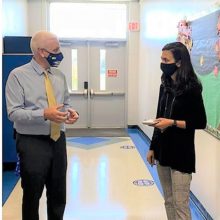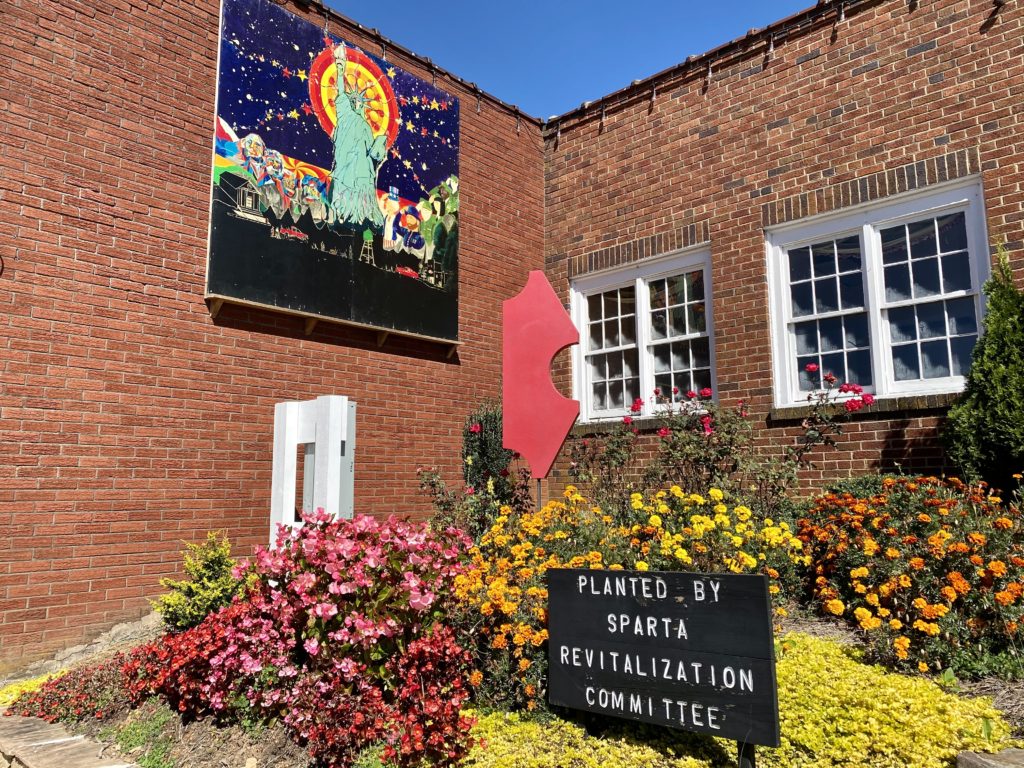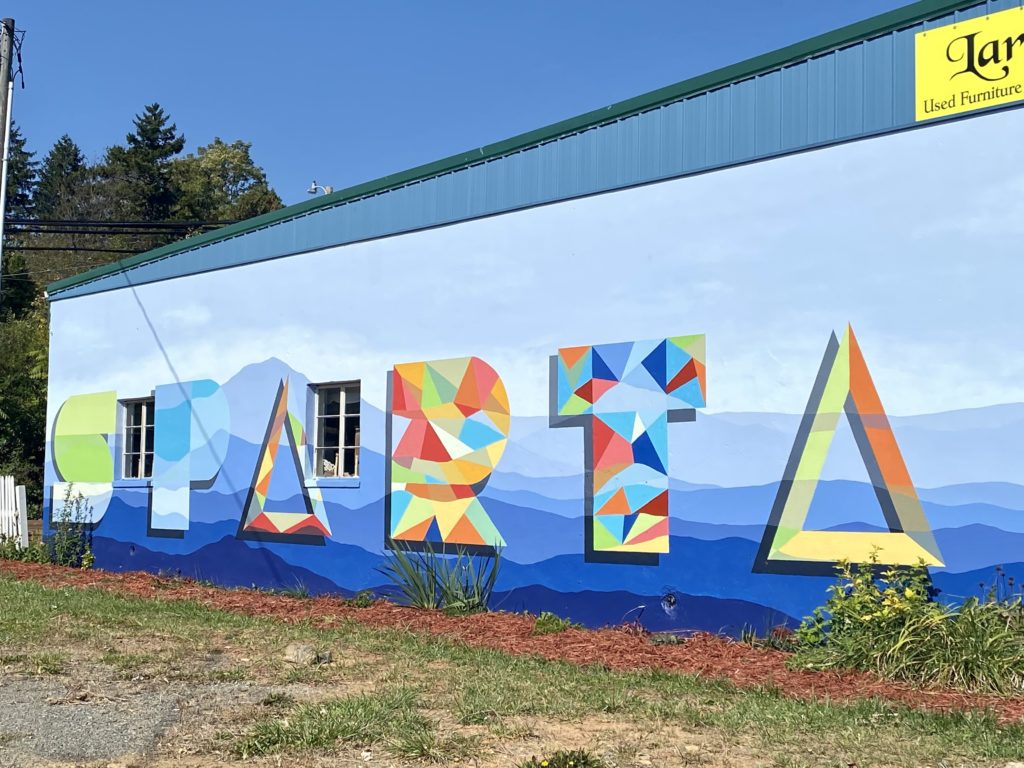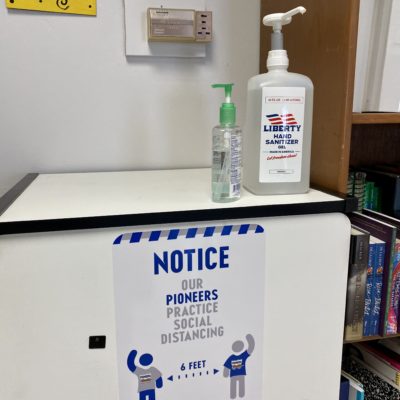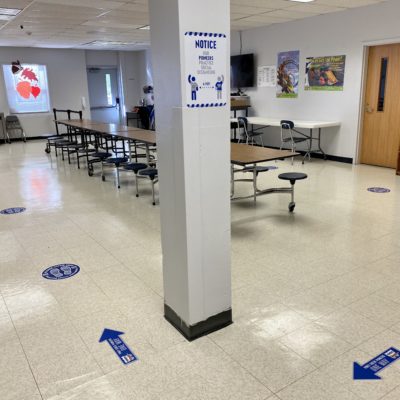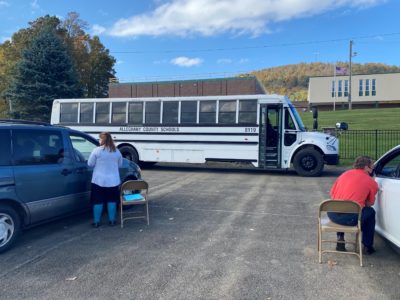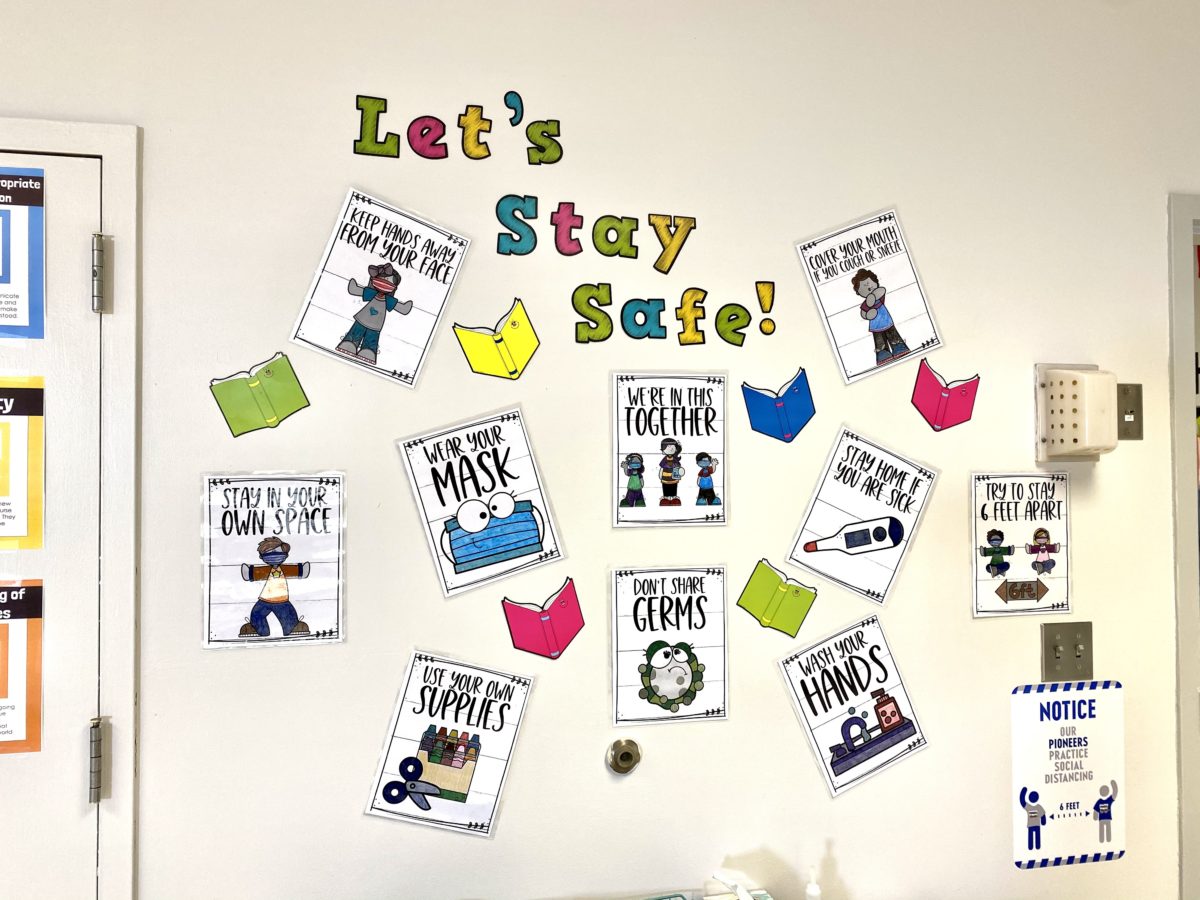
When Gov. Roy Cooper announced in September that school districts had the option to move to plan A — bringing all K-5 students back for full-time in-person instruction — Alleghany County Schools set a plan in motion to make that happen beginning Oct. 12. But in a school board meeting held to review the new plan on Oct. 6, the board instead decided to remain in plan B, a hybrid model, after all.
School reopening decisions are complex. Superintendents and school leaders are considering a variety of factors — from local COVID-19 case numbers to what teachers are comfortable with to the community’s preferences. Information can change on a daily basis, further complicating the decision-making process.

Alleghany County Schools central office. Analisa Sorrells/EducationNC 
A building on Main Street in Sparta, North Carolina. Analisa Sorrells/EducationNC 
A mural in Sparta, North Carolina. Analisa Sorrells/EducationNC
Over the summer, Chad Beasley, superintendent of Alleghany County Schools, organized a cross-functional team of district staff and instructional coaches to determine what plan the district would reopen under in August. At the time, there were three possibilities: plan A (all students back in-person), plan B (hybrid), and plan C (all students remote).
The team sent out surveys to community members, parents, and staff to gauge their preferences. They reviewed guidelines from the state Department of Health and Human Services and met weekly with the local health department. And they drew up plans for A, B, and C and communicated those plans with the school board.
Then, in July, Gov. Cooper announced that districts could choose to open under plan B or plan C. Based on the local COVID-19 case numbers at the time and feedback from the community, Beasley presented plan B to the school board, and it was approved.
Districts choosing plan B also have to provide a fully-remote option for families. At first, Beasley said only about 18% of students wanted to be fully remote. But the number of COVID-19 cases rose in the county the week before school began, and that number jumped to 30%. This anecdote summarizes the nature of making decisions during a pandemic: adjustments have to happen all of the time.

Then came the decision to remain in plan B in October rather than moving to plan A. Two of the factors that converged to keep the district in plan B were guidance from the local health department and the complex logistics that plan A would have required.
According to the district, the school board made the decision to remain in plan B with guidance from AppHealthCare, the local health department. As of Nov. 10, Alleghany County had 353 total COVID-19 cases with 1 death. “Alleghany County Schools continues to keep students and staff safety at the forefront of all that we do,” reads the district’s Facebook post on the decision to remain in plan B.
Then there are the complex logistics. Alleghany County has four schools — three K-8 schools, and one high school. Since plan A is currently only allowed for grades K-5, the logistics to only bring back all K-5 students while leaving grades 6-8 in plan B quickly became complicated. For example, only one student is allowed per bus seat under plan B, but those restrictions are lifted under plan A.
In some cases, that meant the district was considering running separate bus routes for K-5 students and 6-8 students, even though they were all ultimately ending up in the same school building. Bus routes across the district can be long, so running four total routes a day quickly became impractical. And, when a teacher or bus driver has to quarantine due to COVID-19 exposure or miss work for another reason, it’s difficult to find substitutes.
“Once we looked at the challenges that we were facing with our transportation and with our substitutes, [the school board] decided that until we could get K-8 all back on plan A, we would stick with plan B for now,” said Beasley.
Alleghany County, North Carolina
- County seat: Sparta, North Carolina
- Population: 11,137
- Race/ethnicity: 86.7% white, 9.9% Hispanic or Latino, 1.8% Black
- Poverty rate: 18.7%
- High school graduate or higher: 76.6%
- Size: 235 square miles, fifth-smallest county in the state
Source: U.S. Census Bureau QuickFacts
Plan B at Piney Creek
Located just three minutes from the Virginia border, Piney Creek School serves roughly 180 K-8 students. Principal Travis Sturgill grew up in Alleghany County and his lived there most of his life.
Sturgill said roughly a third of students opted for the district’s virtual academy, a fully remote learning option. The remaining students are split into two groups that rotate between one week of in-person instruction, which runs Monday through Thursday, and one week of remote instruction. The one week in-person, one week remote schedule has received positive feedback from parents who say it’s helpful when planning child care.

During the remote instruction week, students work on independent assignments that they select from a choice board. The district is one-to-one, meaning each student has their own Chromebook. Much of Alleghany County has access to fast internet speeds thanks to fiber optic internet that’s offered by a local provider called SkyLine.
When it comes to the day-to-day of being in the school building, even the youngest students have quickly adjusted to the new normal under COVID-19 — keeping socially distant in the hallways, waiting on stickers to pick up lunch in the cafeteria, and staying in their classrooms at dismissal until they are called to the front.

Hand sanitizer and a sign that reminds students to practice social distancing. Analisa Sorrells/EducationNC 
An outdoor classroom in the making. Analisa Sorrells/EducationNC 
Stickers and arrows in the cafeteria direct students while picking up their meals, which are then eaten in the classroom. Analisa Sorrells/EducationNC
When students get off the bus or get out of the car in the morning, they bring along a “passport” — answers to three questions about exposure to COVID-19 and symptoms. Their temperature is also taken. If they don’t have the survey, parents are called, and fourth and fifth graders are allowed to answer the questions for themselves.
Once in the building, signs and stickers are posted reminding students and staff to wear a mask, wait 6 feet apart, and wash their hands. An outdoor classroom is also being constructed.
Sturgill said that before the start of the school year, there was some concern among the staff about how they would ensure students kept their mask on and followed social distancing requirements.
“I thought that might be more of a battle … but that really has not been an issue,” he said.
Despite the challenges that education during COVID-19 brings, Sturgill said there are silver linings. For one, he said discipline issues have been non-existent. And, smaller class sizes allow for more one-on-one instruction.
“The biggest thing that gives me hope is just seeing these kids in the buildings — learning, excited to be there, wanting to come back,” said Beasley.
Teaching in the virtual academy
Kayla Phipps had her first-grade classroom at Piney Creek set up for the new school year when she learned that the district needed someone to be a first-grade teacher in the virtual academy. Just days before the school year began, she accepted the new role and pivoted to preparing entirely remote lesson plans.
“I said, if that’s what you need, I’ll do it,” said Phipps.
Phipps teaches reading to all of the first-graders in the virtual academy, and another teacher provides math instruction. When technology issues pop up, Phipps said she can easily submit a help ticket, and students can swap their devices out for new ones if issues persist.
The first-graders in the virtual academy are also split into an A week and a B week, just like the students who are attending school in-person under plan B. The first week, students attend live Zoom classes and receive new instruction. Phipps’ live reading classes are 35 minutes long. During the second week, they work on assignments and practice what they learned during Zoom, but they don’t attend live classes.

Of the 15 or 16 students that should be in her Zoom classes, Phipps said roughly six to seven of them show up every day. At the end of each Zoom class, Phipps records a summary of what was covered and what the assignments are so that students can catch up on the live classes they missed.
Phipps said it was hard in the beginning to get to know her students. Some students were too shy to say anything at all. But now that her students have settled into the rhythm of remote learning, Phipps can feel her relationships with them strengthening.
“This is the first week I actually felt so connected with my students. This morning, when they all popped in, I could just say ‘Hey, it looks like you got a new hair cut, it looks great!'” she said. “Just little personal things that I know about each one … and the others are listening and smiling because they’re learning new things about their friends’ lives too.”
